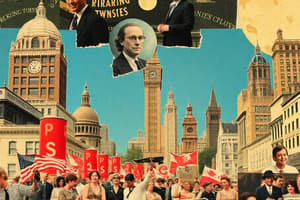Podcast
Questions and Answers
What were some causes of the 1929 stock market crash?
What were some causes of the 1929 stock market crash?
- Government intervention to control stock prices
- Decrease in consumer debt and bank loans
- Stable international agricultural markets
- Overinflated shares from market inflation (correct)
When did the stock market crash begin in 1929?
When did the stock market crash begin in 1929?
- Oct. 29 (Black Tuesday)
- Sept. 24 (Black Thursday)
- Nov. 24 (Black Thursday)
- Oct. 24 (Black Thursday) (correct)
What did the stock market crash of 1929 signal the onset of?
What did the stock market crash of 1929 signal the onset of?
- The New Deal
- The Great Depression (correct)
- The Roaring Twenties
- The Industrial Revolution
What impact did the Great Depression have on American society?
What impact did the Great Depression have on American society?
What effect did the market speculation and overconsumption have on the 1929 stock market crash?
What effect did the market speculation and overconsumption have on the 1929 stock market crash?
What characterized the pop culture of the 1920s?
What characterized the pop culture of the 1920s?
What contributed to the increase in consumerism during the 1920s?
What contributed to the increase in consumerism during the 1920s?
What was a significant characteristic of consumerism in the 1920s?
What was a significant characteristic of consumerism in the 1920s?
How did Calvin Coolidge's policies during the Roaring Twenties impact the economy?
How did Calvin Coolidge's policies during the Roaring Twenties impact the economy?
What was the outcome of the stock market crash in 1929?
What was the outcome of the stock market crash in 1929?
What was a characteristic of the American national economy in the majority of the 1920s?
What was a characteristic of the American national economy in the majority of the 1920s?
What contributed to the onset of the Great Depression?
What contributed to the onset of the Great Depression?
What was a consequence of improvements in technology in the 1920s?
What was a consequence of improvements in technology in the 1920s?
What was a cultural development during the 1920s?
What was a cultural development during the 1920s?
What was a consequence of the Roaring Twenties?
What was a consequence of the Roaring Twenties?
What was a major characteristic of the American national economy in the majority of the 1920s?
What was a major characteristic of the American national economy in the majority of the 1920s?
What was a significant consequence of the Roaring Twenties?
What was a significant consequence of the Roaring Twenties?
What contributed to the Wall Street Crash of 1929?
What contributed to the Wall Street Crash of 1929?
What was a cultural development during the 1920s?
What was a cultural development during the 1920s?
What was a significant characteristic of consumerism in the 1920s?
What was a significant characteristic of consumerism in the 1920s?
What was a significant factor contributing to the economic prosperity in the 1920s?
What was a significant factor contributing to the economic prosperity in the 1920s?
What was a consequence of the culture of consumerism in the 1920s?
What was a consequence of the culture of consumerism in the 1920s?
What was a significant characteristic of consumerism in the 1920s?
What was a significant characteristic of consumerism in the 1920s?
What contributed to the rise of the middle class during the 1920s?
What contributed to the rise of the middle class during the 1920s?
What ultimately contributed to the onset of the Great Depression following the Roaring Twenties?
What ultimately contributed to the onset of the Great Depression following the Roaring Twenties?
Flashcards are hidden until you start studying
Study Notes
The Roaring Twenties: American Companies, Consumerism, and Pop Culture
- World War I dominated global affairs from 1914 until the armistice of November 1918, leading to technological advancements that were incorporated into the society at the opening of the 1920s
- American companies tapped into the emerging consumerist culture by developing new products and manufacturing methods, such as Henry Ford's revolution in automobile manufacturing
- The 1920s saw a major increase in global markets, with American companies expanding internationally and foreign enterprises seeking to establish themselves in the US
- Corporations revolutionized advertising, driven by new technologies and the widespread access to radio, leading to the evolution of advertising techniques according to consumer psychology
- Rising wages, driven by prosperous corporations and strong macroeconomic conditions, encouraged consumerism, enabling the purchase of new products and goods on credit
- Consumerism in the 1920s had both positive effects, transforming American life with new products, and negative effects, as some individuals struggled with debt and purchasing frenzies
- Purchasing on credit was a significant characteristic of the time, with over half of the automobiles in the United States sold on credit plans, and consumer debt more than doubling between 1920 and 1930
- The pop culture of the 1920s, also known as the Jazz Age, introduced nationalized pop culture, new music genres, youth culture, and the rise of flappers, who pushed for women's independence
- Politically, Calvin Coolidge, US's thirtieth president, benefited from the strong economic conditions with his hands-off regulatory approach and emphasis on tax cuts and business interests
- By the end of the 1920s, the stock market had grown at unsustainably high rates, leading to a cycle of increasing investments due to the money to be made in the market
- Coolidge's policies during the Roaring Twenties were popular but ignored increasing wealth inequality and encouraged reckless market gambling, contributing to the speculation that led to the stock market crash
- The stock market crash in 1929 revealed the far less stable economic foundation of the Roaring Twenties, leading to the onset of the Great Depression.
Studying That Suits You
Use AI to generate personalized quizzes and flashcards to suit your learning preferences.




